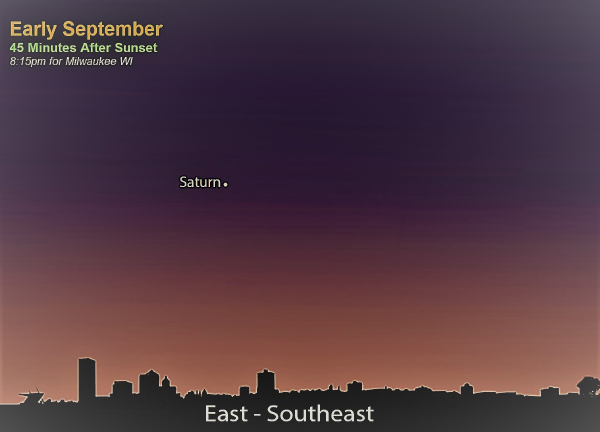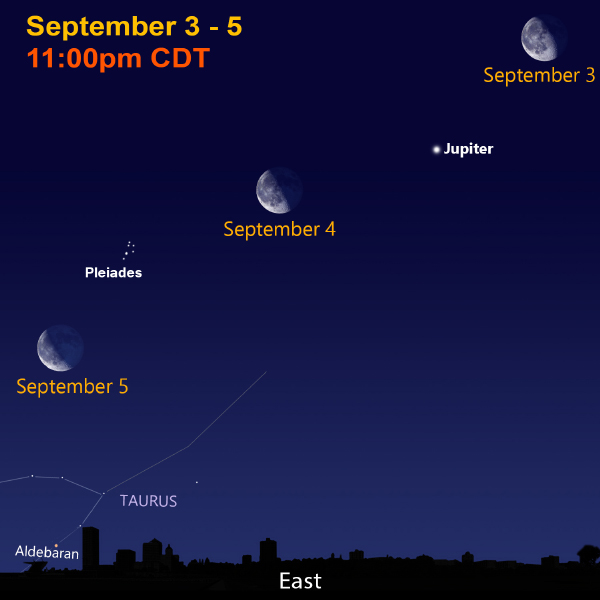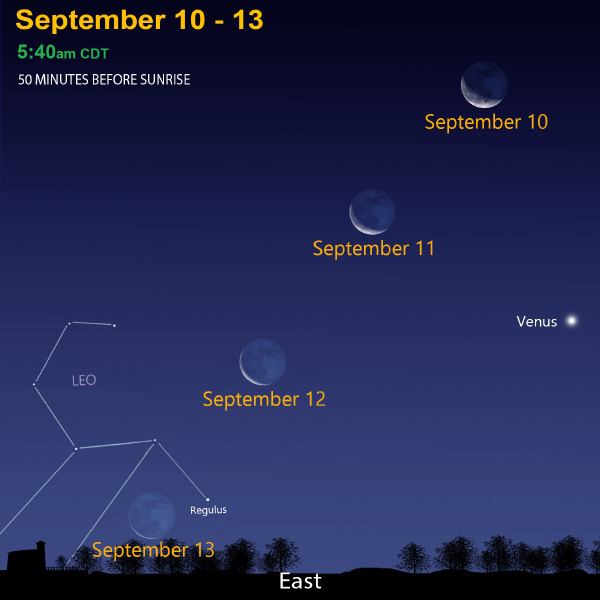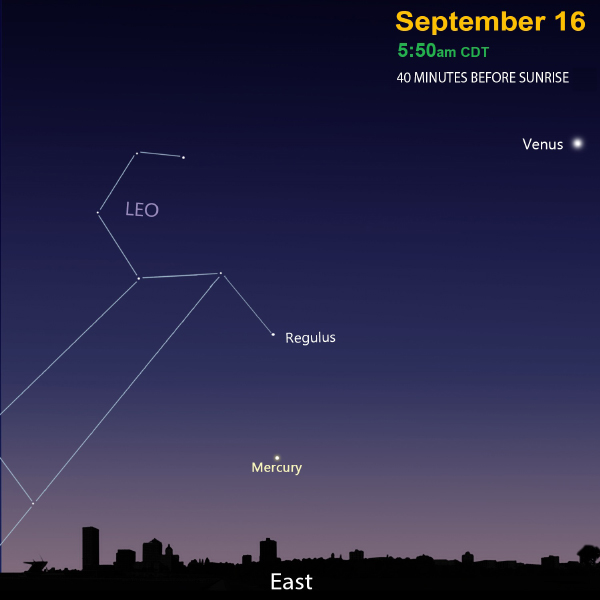Cosmic Curiosities
" Weather forecast for tonight: dark.”
- George Carlin, American Comedian
Harvest Moons?
I always feel autumn is the best time for stargazing: There’s more night sky with sunsets earlier and sunrises later. The weather is still warm, but if chilly, we just put on a sweatshirt. And the bugs… Well, hopefully, they are less annoying!
There are beautiful moonrises, like a pale-yellow Harvest Moon. Or moons. Technically, the Harvest Moon is singular; it is the full moon nearest the first day of fall, which this year begins on September 23, at 1:50 a.m. CDT. This year, the moon grows whole on September 29.
So, what’s up with “Harvest Moons”? On average, the moon rises almost an hour later each night. But near the autumnal equinox, the moon rises only 30 minutes later.
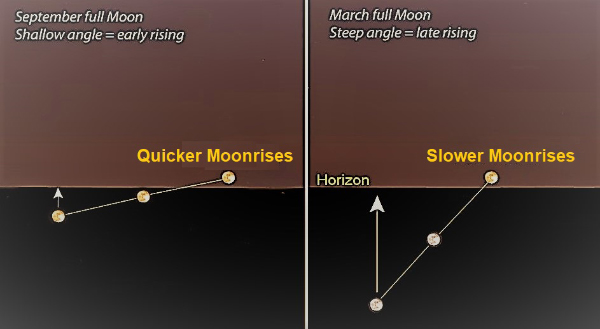
This effect is caused by the moon’s orbit and its shallow angle to the eastern horizon at this time of year. In spring, the moon’s orbit is much steeper to the horizon and the effect is just the opposite with a long delay between moonrises. With these quicker moonrises after sunset, farmers use the extra moonlight to help them bring in their harvest. It looks and feels like we have about three or four full moons in a row. Thus, the Harvest Moons, plural!
So step outside this late September and enjoy the extra moonlight that a changing angle can cause. Shine on, Harvest Moons!
The Dark Side—Illuminated!
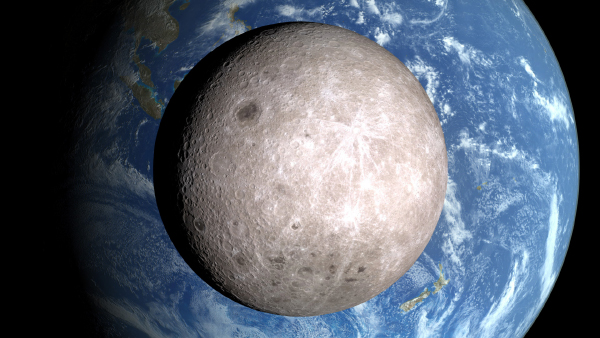
From Earth, we never see this dark side of the moon, except maybe when we're listening to Pink Floyd. However, the “dark side of the moon” can be seen just fine—thanks to NASA’s DSCOVR (Deep Space Climate Observatory) satellite. The spacecraft is parked in an orbit a million miles from Earth—four times the distance of the Moon.
DSCOVR is designed more to study the solar wind’s effect on the Earth; its lofty position can easily glimpse us and our neighbor. Here on Earth, we always see the same side of the moon, night after night. Why? Some say this is because the moon doesn’t rotate on its axis.
This is not true and can easily be proven. All you need is a quarter (the Earth) and a penny (the Moon). Move the penny once around the quarter but keep the top of Lincoln's head facing the quarter. In other words, make sure people on the quarter—aka Earth—always see the top of Lincoln’s head, aka the moon.
As you move the penny around the quarter, notice how you need to spin (or turn) the penny to keep Lincoln's head in the same position. After you slid the penny all the way around the quarter just once, you have also spun the penny once! That’s synchronous rotation. The moon’s orbit time equals its spin time; that’s why we on Earth always see the same side of the moon.
Did you know Pink Floyd taught a little astronomy at the end of their famous album? The last lines of the last song say, "There is no dark side of the moon, really. Matter of fact, it's all dark." This is true because the moon does not make its own light – it shines by reflecting sunlight.
Of course, this means you could say the Earth is all dark, too.
Come see our new Pink Floyd show and learn even more!
How to Make a Thunderstorm
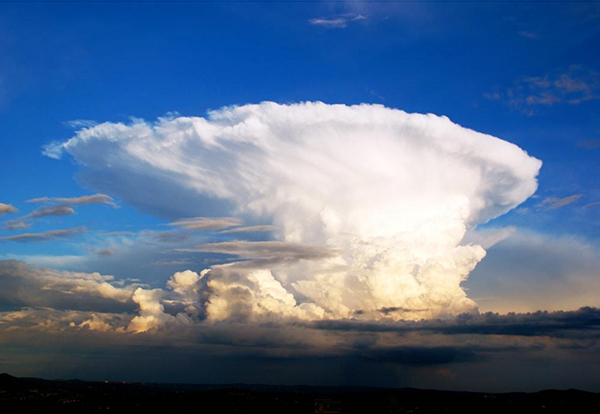
Thunderstorms are awesome. Have you ever seen one form on the horizon? The clouds seem to touch the top of the atmosphere with a flat head and unnervingly defined cauliflower exterior.
Thunderstorms need three basic ingredients: moisture, rising unstable air, and something to start the lifting process. As the air rises, it forms a low-pressure zone. With increasing altitude, the temperature of the air parcel decreases, causing water vapor to condense into droplets and form a cloud. This warm air rising is called an updraft. It often comes from heat radiating up from the sun-warmed ground.
As warm air continues to rise from below, the puffy cumulus clouds will grow in height into cumulus congestus clouds, and eventually, a thunderhead, or cumulonimbus cloud.
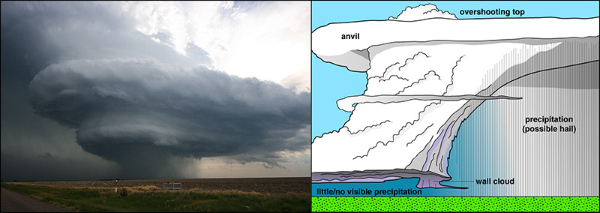
If the warm updraft continues, the cloud will keep growing and puffing. It may even reach its maximum height at the edge of the tropopause, about six miles up. Here, air is forced to spread out, resulting in the flattened “anvil” shape.
Within the cloud, more water vapor condenses into water droplets, darkening the color of the cloud. As the droplets flow up, cold temperatures freeze the water into graupel (soft hail) and ice crystals. If the updraft can no longer hold up the weight of the water, and cool dry air starts to flow downward in a downdraft, it pulls the graupel down and results in rain. If the updraft is strong enough, the pellets may remain aloft long enough to freeze over and form into larger hailstones. The largest hailstone ever recovered was eight inches across!
This internal turbulence is also the mechanism leading to high winds and possible tornadoes. This chaotic movement of water and air also creates electrical charges—lightning! This may be caused by the triboelectric effect, the same charge that occurs when you rub a balloon on your head and your hair stands up.
When the downdrafts become stronger than the updrafts within the cloud, the storm weakens and begins to dissipate from bottom to top. Time to breathe a little easier.
A Lonely Star
Fomalhaut is the 15th brightest star in the Wisconsin night sky. Some stargazers call it the Loneliest Star, because there are no other bright stars near it. Sometimes, a planet shines nearby. Saturn shines nearby now.
Autumn is the best time to spot Fomalhaut. It follows a shallow arc low in the south sky. Shining near the horizon, this star passes through more air, causing lots of twinkling. To find Fomalhaut, you can use the Great Square of Pegasus, then point south and look for Fomalhaut low in the southern sky.
In Arabic, Fomalhaut means "the mouth of the fish.” It’s located in the constellation of Pisces Austrinus, or the southern fish.
Fomalhaut is “only” 25 light years away and almost twice the size of the sun. It is also much younger than our sun – 440 million years old compared to 5 billion years.
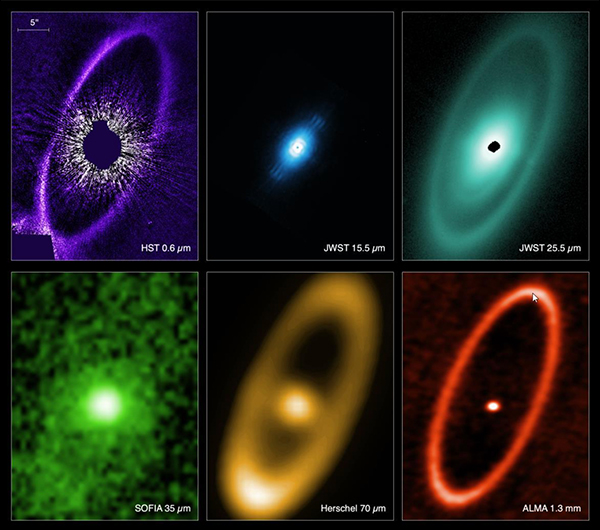
From JWST, it was found that there are several debris disks around it. There are three nested disks that one could compare to our asteroid belt and Kuiper belt around our sun. Astronomers have known a debris cloud surrounds Fomalhaut for many years, as the picture above shows six different views from various Earth and space telescopes. The disks are complex and mysterious. There’s possible evidence of suspected planets in formation—and maybe even collisions between planets! These belts extend out to 14 billion miles from the star.
By studying Fomalhaut’s belts and the intricacies of early planetary formation, astronomers will gain more insight into the origins of our own solar system.
Space in Sixty Seconds
Explore how small our sun is compared to bright stars in the September night sky.
Sky Sights
Spot Saturn all alone in the early evening sky. The Moon will shine nearby the ring jewel on September 26.
Stay up a little late and catch bright Jupiter and the Moon shining together on the mornings of September 3-5.
Venus will be easy to see in mid-September, especially with a waning crescent Moon orbiting by from September 10-13.
Mercury joins the morning sky in mid-September. Though never easy to spot, give a try low in the east if you are an early riser.
Mars is unfortunately too close to the sun to be seen for the rest of 2023.
September Star Map
Sign Up
Receive this newsletter via email!
Subscribe
See the Universe through a telescope
Join one of the Milwaukee-area astronomy clubs and spot craters on the Moon, the rings of Saturn, the moons of Jupiter, and much more.
Follow Bob on social media
Twitter: @MPMPlanetarium
Facebook: Daniel M. Soref Planetarium


